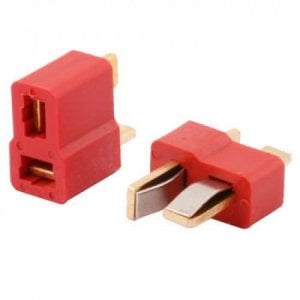Stupid Mistakes Playing with Electricity
Mistake #1: Electrocuting myself after Changing the connectors for LiPo Battery
Around summer of 2021 Context I ordered a LiPo (Lithium Polymer) battery from Amazon, only to realize when it arrived at my house, that the connector was not the one I used.
Before this, I was not aware that there are actually more than 16 different types of LiPo Battery connectors that exist. I had assumed that all LiPo batteries come with industry-standard connectors. This is not the case.
Different types of connectors exist to tolerate different amperages. For instance, JST connectors are rated for around 1-10 amps. As such, they are designed for smaller applications such as powering a mini-drone.
On the other hand, larger adaptors exist to withstand stronger currents. In the case of the LiPo battery I had just purchased, it was a 2S 7.4V battery rated at 5200mAh and 50C. It came in a T-plug connector, which looks like this:

However, I used XT-60s both for my LiPo battery charger and to connect to my electronic speed controller.

I forgot about the basic working principles of electricity
To replace the T-Plug connector with an XT-60 connector, I simply needed to cut the wires of the battery and solder the new connectors onto it. It was then I made one of the stupidest mistakes of my life:
Instead of cutting one wire at a time, I accidentally cut both the red wire (representing the positive side) and the black wire (representing the negative/ground side) at the same time. As such, I effectively created a closed circuit with my pair of scissors. The moment my scissors closed the circuit, sparks flew out of the wires, and I felt a small shock run through my body, as it acted as a resistor through which my fully charged battery of around 8 volts flowed.
Batteries are super dangerous. They store a lot of potential energy in the form of chemical energy. But from the outside, these batteries seemed harmless to me. I knew that electricity (electrons) flowed when a circuit was closed. When a LiPo battery is disconnected, its circuit is open, which means that no electricity can flow. This DOESN’T means, however, that it is still VERY dangerous. I made this silly mistake of assuming it was not dangerous and gave myself a small electric shock.
Luckily, this was only 8V. A human body can tolerate much higher voltages before any permanent damage can be done to the human body. That being said, you should never risk trying to get external current run through your body.
However, I am grateful for this experience, for it has scarred me for life and I will never make the same mistake again.
Mistake #2: Frying my Arduino Nano after a Arduino Nano after a Short Circuit
To properly control my motorized toilet paper dispenser, I needed to attach an Arduino Nano to the ESC (electronic speed controller) in order to send instructions on how fast the motor should be spinning. For this reason, I wanted to add two other components: a potentiometer and a mechanical switch. I only did the testing with the potentiometer, and it was working perfectly fine. However, when I soldered everything and added the switch, and turned everything on, a small smoke suddenly came out of my Arduino: I had just short-circuited it.
Worst, I couldn’t even identify what the issue was. I was too confident in creating the wires in my head, but it obviously came short because the logic in my head was completely wrong. In the future, I will always first draw circuit diagrams, planning all my wiring ahead instead of trying to wing it, which could lead to inadvertently frying my 7$ Arduino Nano. In the end, I will be saving myself a lot of energy trying to figure out what went wrong.
Mistake #3: Frying my Raspberry Pi after connecting it to a DC motor
Well, I’m not sure I actually fried it since it still seems to work, but I powered the dc motor directly with my raspberry pi. I let it run for a minute, it seemed fine at first, but then smoke started coming out.